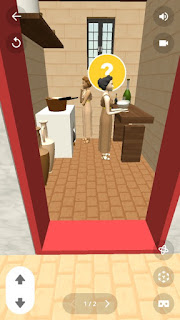Breathless!
The Swiss psychologist, Piaget, known for his work in child development, believed that children construct an understanding of the world around them, experience discrepancies between what they already know and what they discover in their environment, then adjust their ideas accordingly. In other words, they learn by experience.
This week's classwork was the exploration of AR and VR and its application to classroom teaching. So, if experience is the best teacher...
That's me wearing an Oculus headset and working through an Engage Immersive Education VR program. Their tagline is Learn Through Experience.
What is theater if not virtual reality? When we are in an audience, we are asked to willfully suspend disbelief and intentionally avoid logical thinking in examining something surreal in order to believe it for the sake of enjoyment. And when we are the actor on stage taking on the role of another person, we must create an alternative reality in which to live and behave.
The more "real" a student/actor can portray that reality, the more real the experience for both actor and audience. VR might be an opportunity for acting students to experience environments and to hold objects that will allow them to get further "into character."
Establishing myself in my chosen Oculus-rendered environment, a primitive, undeveloped yet fertile landscape, made me consider how a director/teacher might create an environment/stage set for a particular theater piece/curriculum and have the actor/student virtually exist within it in order to get a deeper experience, one that she can bring to her performance and, by extension, internalize the required information. (This concept is not unlike the immersive Anne Frank house VR that Jesse Lubinsky showed to our class.)
Once I was immersed in the Engage environment, the VR program created a set of markers that determined the area that I could move around in and 'virtualized' my hands so that I could raise them and see a VR version of the controllers. Using them, I selected large animals to inhabit the landscape and manipulated them within the space. While at no time did I believe that what I was seeing was in any way real, the encounter was instructive and one that I could never have in reality. The platform has a library of possible environments and choices within them. Engage Immersion Education VR also has several powerful VR history experiences including Apollo 13, Titanic and the Berlin Blitz.
Another possible VR experience, similar to what Jesse Lubinsky had us engage in on hubs.mozilla, might be for students to create avatars that are the characters in a curriculum drama piece. Students are already familiar with this kind of play with Sims and other life-simulation types of games. A teacher could run the environment from a computer while the avatar/characters perform the play in an environment that would be almost impossible to recreate outside of VR.
In CoSpaces EDU, which I downloaded and played around with, I pulled up an environment that might appear in one of my ancient history curriculum plays (i.e. an ancient Roman house.) My students could spend time in that house, learning about that architecture and the utility of the spaces within and how best to portray their character in that space within the context of a storyline and do this before they needed to perform on stage.
I did my own tour through the house and it gave me ideas for both a stage set as well as the vocabulary and personae I might chose.
Further delving into CoSpaces EDU, I found a template for a museum. With it, you can create a two-story museum space in VR. There is space for twelve exhibits with lots of wall space. By adding videos and images, I could create an interactive VR museum. Creating a 'headshot' wall of actors for a show, the set images for the ultimate realization of the space on stage or even a storyboard of the narrative, students can manipulate this template to engage in the environment as a VR expression of the story or play.
AR and VR tools allow for distance learning and collaboration between educators and learners across the world, in real time. In the same way that recording artists now 'meet' to work through music tracks electronically while thousands of miles apart, teachers can reach their students and guide them through virtually so that the experience of learning can happen.
~ J





January,
ReplyDeleteI loved your report on getting to play with the Occulus (and congrats to your son for doing what seems like great doctoral research).
This really knocked me out:"What is theater if not virtual reality? When we are in an audience, we are asked to willfully suspend disbelief and intentionally avoid logical thinking in examining something surreal in order to believe it for the sake of enjoyment. "
I am wondering if you would say the same about a classroom or other educational experience. What do you think?
Spot on application to the world of theater! I felt exactly the same way. As a former actor (I did a few shows growing up... not easy stuff so I applaud you for your passion in the arts!), I would be frequently told to truly believe that I lived as the character in the scene. What better way to do this than by actually "leaving" our own reality and "entering" a new one. Also, the Oculus is incredible. I can hardly make it through the VR horror scenes that you can experience on there!
ReplyDelete